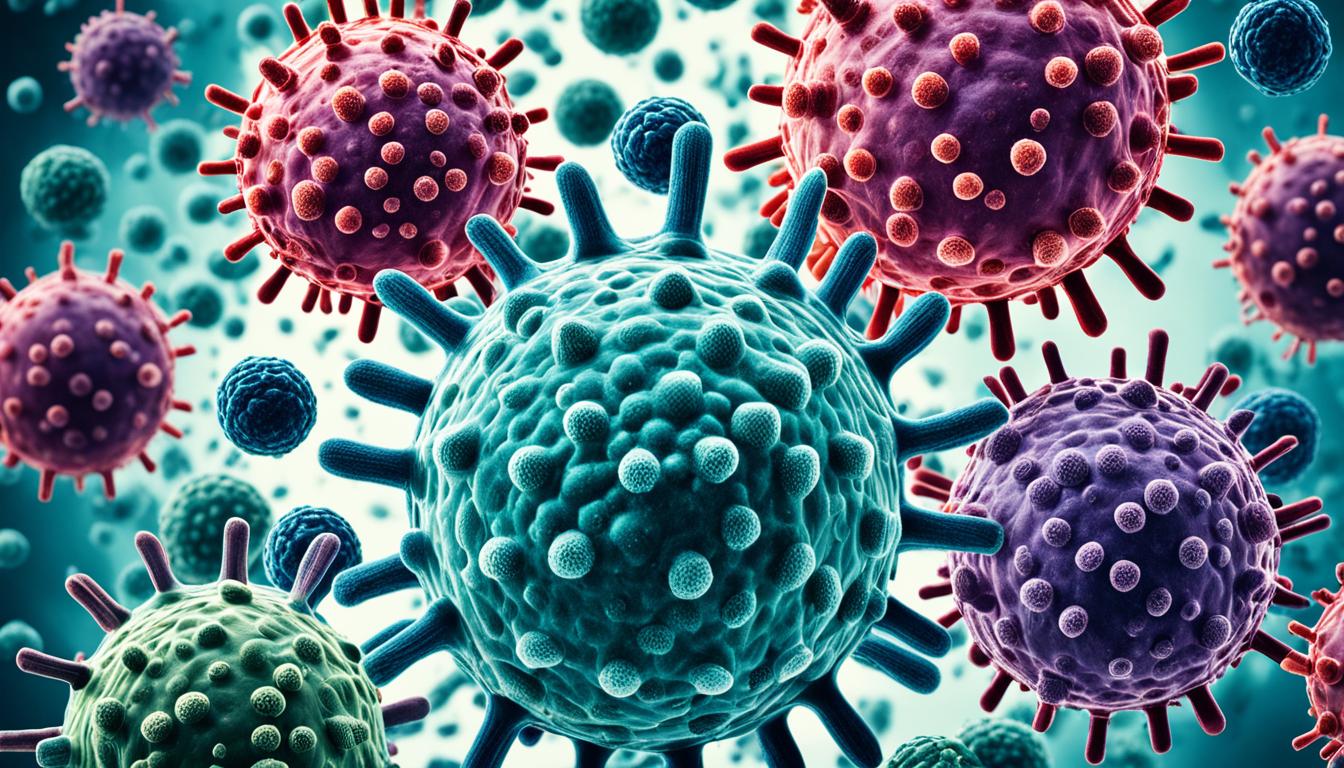Smallpox is an infection caused by the Variola virus. It leads to a fever, rash, and can be deadly. Two types exist: one is severe, the other less so. The severe type has a 30-50% death rate in unvaccinated people, while the milder form’s death rate is around 1%. Thanks to medical progress, smallpox was wiped out in 1979 through a major global effort.
The Variola virus is a member of a big family of DNA viruses. Diagnosing smallpox means checking symptoms and running tests. These tests include isolating the virus and using special genetic tests. Although smallpox vaccines are there to fight it, most people don’t need routine vaccination against it.
Key Takeaways:
- The Variola virus causes smallpox, an acute infection with high mortality rates in unvaccinated individuals.
- Smallpox has two main types: severe form (30-50% mortality) and milder form (1% mortality).
- Smallpox was declared eradicated in 1979, a major milestone in medical history.
- The diagnosis of smallpox involves clinical examination and laboratory tests, including isolating the virus.
- Vaccination is recommended for smallpox prevention, although routine vaccination is not necessary for the general population.
Smallpox Symptoms and Complications
Smallpox shows many symptoms that help identify it. Some common ones are high fever and severe headache. People might also have vomiting, diarrhea, back pain, and feel very tired.
The disease moves through different stages. Lesions first appear in the mouth and then a rash starts on the skin. This rash starts as bumps and blisters, then becomes papules, vesicles, and pustules.
It’s also possible to get complications from smallpox. These may include infections from bacteria and inflammation of different parts of the body. Blindness, pneumonia, and problems with the brain or testicles can occur, among other issues.
Spotting these symptoms early is key to good treatment. Quick medical help can lessen the chances of having serious complications.
| Smallpox Symptoms | Smallpox Complications |
|---|---|
| High fever | Secondary bacterial infections |
| Severe headache | Keratitis leading to blindness |
| Vomiting | Bacterial pneumonia |
| Diarrhea | Viral arthritis and myelitis |
| Back pain | Orchitis (inflammation of the testicles) |
| Fatigue | Encephalitis (inflammation of the brain) |
Smallpox Diagnosis and Prevention
Diagnosing smallpox means looking at the patient and doing tests. Doctors first see the patient’s symptoms. They check for signs like fever and a rash. These are similar to other virus infections. So, tests are needed to be sure it’s smallpox.
The Variola virus is found in samples like from the throat, eyes, and urine. Doctors test these to see if the virus is there. A test called PCR is used. It finds pieces of the virus’s genetic material. This test confirms if it’s smallpox.
Using a blood test to see if the body has fought the virus before can help. But, this blood test doesn’t confirm smallpox. The PCR test is the best to diagnose smallpox.
To stop smallpox from spreading, many steps are taken. This includes isolating people with the disease. It also means healthcare workers must wear special clothing, like gloves and masks, around these patients.
Vaccines are very important in stopping smallpox. The smallpox vaccine has worked well. Because of this, most people don’t usually need it. But, doctors suggest it for those who might be around the virus a lot. They also recommend it for travelers going to places where smallpox is common.
Prevention measures for smallpox:
- Isolation of patients with rash
- Use of personal protective equipment
- Smallpox vaccination
By taking these steps, the healthcare system can fight against smallpox. They can stop the disease from spreading and save lives.
Stem Cell Therapy for Smallpox Treatment
Stem cell therapy offers new hope in battling smallpox. Researchers are looking into using a mix of a poxvirus and stem cells. They hope this combo can help fight off diseases with ongoing inflammation, like smallpox.
The idea is to use the poxvirus to create a quick, intense inflammation. Then, stem cells step in to adjust the immune response and start the healing process. This might change ongoing inflammation to a quicker, more effective response, bettering smallpox patient outcomes.
Initial findings on stem cell therapy for smallpox are positive. But, more studies are required. Scientists aim to better understand how safe and effective this therapy is. They want to make sure it’s a dependable choice in the future.
FAQ
Q: What is smallpox?
A: Smallpox is a severe sickness caused by the Variola virus.
Q: What are the symptoms of smallpox?
A: It shows with a high fever, bad headache, vomiting, and diarrhea.
Often, people also feel back pain and very tired.
Q: What are the complications of smallpox?
A: If someone gets smallpox, they might also face other bad issues.
This includes infections, blindness, pneumonia, and more serious sicknesses.
Q: How is smallpox diagnosed?
A: Doctors check for smallpox by looking closely at a patient’s symptoms and doing tests.
These tests include finding the virus and using a special technique called polymerase chain reaction assays.
Q: How can smallpox be prevented?
A: We can stop smallpox by isolating those with a rash, using protective gear, and giving vaccines.
Q: Is vaccination necessary for the general population?
A: For most people, getting a smallpox vaccine isn’t needed.
Q: What is stem cell therapy for smallpox treatment?
A: Stem cell therapy might help by changing how the body’s reaction happens.
It looks to make the illness less serious by doing this.
Q: How effective is stem cell therapy for smallpox treatment?
A: But, we still don’t know enough about how well stem cell therapy works for smallpox.
More research is important to find out its benefits and risks.

